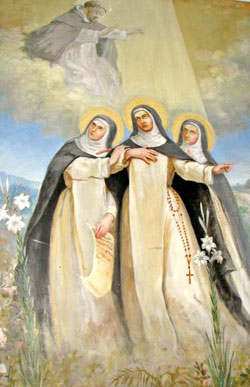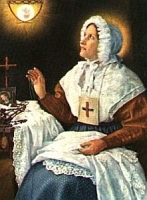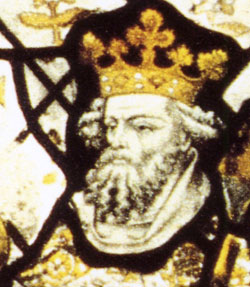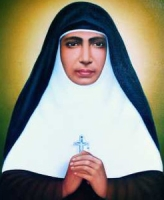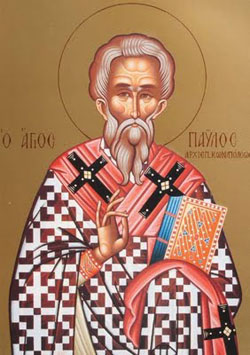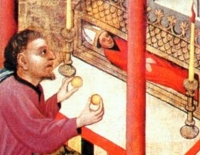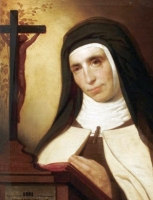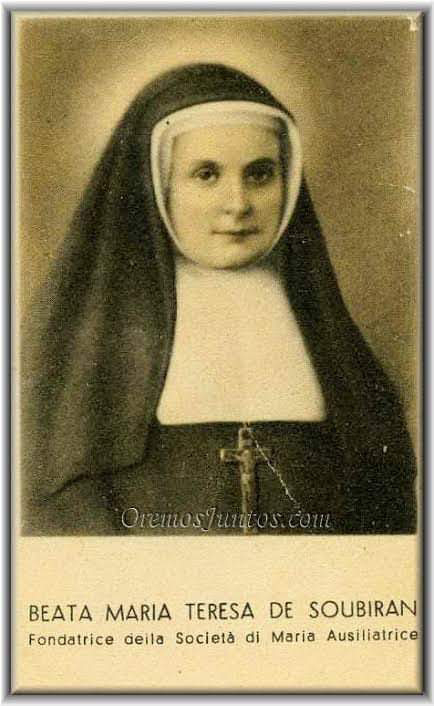St. Jose de Anchieta
Feastday: June 9
Patron: Catechists, of those who suffer scoliosis and compatrono of Brazil
Birth: March 19, 1534
Death: June 9, 1597
Beatified: June 22, 1980, Saint Peter's Square, Rome, by Pope John Paul II
Canonized: April 3, 2014, Vatican City, by Pope Francis
José de Anchieta (March 19, 1534 - June 9, 1597) was a Canarian Jesuit missionary to Brazil in the second half of the 16th century. A highly influential figure in Brazil's history in the 1st century after its discovery on April 22, 1500 by a Portuguese fleet commanded by Pedro Álvares Cabral, Anchieta was one of the founders of Săo Paulo, in 1554, and Rio de Janeiro, in 1565. He was a writer and poet, and is considered the first Brazilian writer. Anchieta was also involved in the catechesis and conversion to the Catholic faith of the Indian population; his efforts at Indian pacification, together with another Jesuit missionary, Manuel da Nóbrega, were crucial to the establishment of stable colonial settlements in the new country.
Bl. Diana
Feastday: June 9
A member of the d'Andalo family, Diana was born near Bologna Italy, and convinced her father to withdraw his opposition to the founding of a Dominican priory on land he owned in Bologna. Dominic received her vow of virginity, but she was forced to remain at home by her family. Later she joined the Augustinians at Roxana but was forcibly removed from the convent by her family. She was injured in the struggle but later escaped and returned to Roxana. Sometime later Blessed Jordan of Saxony convinced the family to found a Dominican convent in 1222 for her, staffed with Diana and four companions and four nuns brought from Rome, two of them Cecilia and Amata. Diana died on January 9, and when Cecilia and Amata died, they were buried with her. All three were beatified in 1891. Feast day is June 9th.
Saint Columba of Iona
Also known as
• Apostle of the Picts
• Apostle to Scotland
• Coim, Colmcille, Colum, Columbkill, Columbkille, Columbus, Columcille, Columkill, Combs
Additional Memorials
• 6 January as one of the Twelve Apostles of Ireland
• 17 June translation of relics
Profile
Born to the Irish royalty, the son of Fedhlimidh and Eithne of the Ui Neill clan. Bard. Miracle worker. Monk at Moville. Spiritual student of Saint Finnian. Priest. Itinerant preacher and teacher throughout Ireland and Scotland. Spiritual teacher of Saint Corbmac, Saint Phelim, Saint Drostan, Saint Colman McRhoi and Saint Fergna the White; uncle of Saint Ernan. Travelled to Scotland in 563. Exiled to Iona on Whitsun Eve, he founded a monastic community there and served as its abbot for twelve years. He and the monks of Iona, including Saint Baithen of Iona and Saint Eochod, then evangelized the Picts, converting many, including King Brude. Attended the Council of Drumceat, 575. Legend says he wrote 300 books.
Born
7 December 521 at Garton, County Donegal, Ireland
Died
• 9 June 597 at Iona, Scotland, and buried there
• relics translated to Dunkeld, Scotland in 849
Patronage
• against floods
• bookbinders
• poets
• Ireland
• Scotland
• 5 dioceses, 2 cities
Saint Ephrem of Syria
நிசிபிஸ் புனித எஃப்ரெம்
பிறப்பு : 306, நிசிபிஸ்
இறப்பு : ஜூன் 09, 373
நினைவுத் திருநாள்: ஜுன் 09
எஃப்ரேம், 306 ஆம் ஆண்டு, மெசபடோமியாவில் உள்ள நிசிபிஸ் என்னும் இடத்தில் பிறந்தார். இவருடைய தந்தை பிற சமயத்தைச் சார்ந்தவர். ஆனால், எஃப்ரேமோ கிறிஸ்தவ விசுவாசத்தில் அதிகமான ஈடுபாடு வாழ்ந்து வந்தார். இதனால் அவருடைய தந்தை அவரை வீட்டை விட்டே துரத்திவிட்டார். எஃப்ரேம் வீட்டைவிட்டு வெளியே வந்து நிசிபிசில் ஆயராக இருந்த ஜேம்ஸ் என்பவரிடத்தில் தஞ்சம் புகுந்து கல்வி கற்றார். ஏறக்குறைய எட்டு ஆண்டுகள் அவரோடு இருந்து எல்லாவிதமான பயிற்சிகளையும் பெற்ற இவர், அதன்பிறகு பாலைவனத்திற்குச் சென்று தனிமையில் சில காலத்தைச் செலவழித்தார்.
363 ஆம் ஆண்டு நாட்டில் ஏற்பட்ட அரசியல் குளறுபடிகளின் காரணமாக இவர் எடேசாவிற்கு செல்ல நேர்ந்தது. அங்கே இவர் தியாக்கோனாக இருந்து பல்வேறு விதமான பணிகளைச் செய்தார். ஏற்கனவே அறிவிலும் ஞானத்திலும் சிறந்துவிளங்கிய இவர் அப்போது திருச்சபைக்கு மிகவும் அச்சுறுத்தலாக இருந்த பலவிதமான தப்பறைக் கொள்கைகளை மிகத் துணிவோடு எதிர்த்து வெற்றிகொண்டார். மேலும் இறைவன் இவருக்கு நல்ல எழுத்துத் திறனைக் கொடுத்திருந்தார். அதைக் கொண்டு இவர் பல மறையுரைகளை எழுதினார். இது மட்டுமல்லாமல், திருச்சபையின் வரலாற்றில் முதல்முறை திருவழிபாட்டுப் பாடல்கள் மூலம் இறைமக்களுக்கு பல உண்மைகளை எடுத்துச் சொன்னார்.
இப்படி நாட்கள் நகர்ந்துகொண்டிருக்க எடேசாவில் மிகப்பெரிய பஞ்சம் உண்டானது. அந்நாட்களில் மக்கள் உணவிற்காக மிகவும் கஷ்டப்பட்டார்கள். அப்படிப்பட்ட சமயத்தில் இவர் மக்களுக்கு மத்தியில் இறங்கி பணிசெய்யத் தொடங்கினார். குறிப்பாக இவர் வசதிபடைத்தவர்களிடமிருந்து தேவைக்கு மிகுதியாக இருந்த உணவுப் பொருட்களை வாங்கி, அவற்றை தேவையில் இருந்த மக்களுக்குப் பகிர்ந்து கொடுத்தார். இவ்வாறு அங்கு ஏற்பட்ட பஞ்சத்தை ஓரளவு சமாளித்தார்.
இப்படி பல்வேறு பணிகளைச் செய்து, திருச்சபையை எதிரிகளிடமிருந்து காப்பாற்றி, தன் வாழ்நாள் முழுக்க ஒரு திருத்தொண்டராகவே இருந்த எஃப்ரேம் 373 ஆம் ஆண்டு இறையடி சேர்ந்தார். இவருக்கு 1920 ஆண்டு மறைவல்லுநர் பட்டம் கொடுக்கப்பட்டது.
Also known as
• Ephrem of Edessa
• Ephrem the Syrian
• Ephraem...
• Ephraim...
• Ephraem Syrus
• Deacon of Edessa
• Harp of the Holy Spirit
• Jefrem Sirin
• Sun of the Syrians
Additional Memorials
• 28 January (Eastern Orthodox; Eastern Catholic)
• 8 June (Scottish Episcopal)
• 10 June (Wales; Episcopal Church in the USA)
• 18 June (Maronite Church)
• 7th Saturday before Easter (Syriac Orthodox Church)
Profile
May have been the son of a pagan priest. Brought to the faith by Saint James of Nisibis, and baptized at age 18. Helped to evangelize Nisibis, Mesopotamia. May have attended the Council of Nicaea in 325. Deacon. Preacher. Had a great devotion to the Blessed Virgin Mary. In 363 Nisibis was ceded to Persia; a great persecution of Christians began, and Eprem led an exodus of the faithful to Edessa. Founded a theological school in Edessa. Wrote homilies, hymns and poetry. Helped introduce the use of hymns in public worship. Fought Gnosticism and Arianism by his writings, including poems and hymns. Proclaimed a Doctor of the Church in 1920.
Born
c.306 at Nisibis, Mesopotamia (in modern Syria)
Died
• 9 June 373 at Edessa (in modern Iraq) of natural causes
• tomb in Armenian monastery, Der Serkis, west of Edessa
Patronage
• spiritual directors
• spiritual leaders
Blessed Anne Marie Taigi
Also known as
• Anna Maria Gesualda Antonia Taigi
• Anna Maria Taigi
• Anne Marie Gianetti
Profile
Daughter Luigi Giannetti and Maria Masi. Her father was a pharmacist in Siena, Italy, but his business went bankrupt when Anna Marie was five years old. The family moved to Rome, Italy in search of work, but Luigi could only find a job as a household servant. Anne was married on 7 January 1789 to Dominico Taigi, a butler to the noble family of Chigi. She was married for 48 years, and mother of seven, two of whom died very young.
Anne Marie was always very concerned about her dress and appearance, far more than would be expected of a working class mother. Life at home was not always peaceful, Dominico could be ill-tempered and caustic, and Anne was known to have had an adulterous affair with an older man. But one day while at prayer at Saint Peter's Cathedral, she felt a sudden strong inspiration to ignore the things of this world. She began to live a more austere life, and to listen to the Spirit. Trinitarian tertiary. She found holy spiritual directors, gave all she could to the poor, visited the sick, and counselled many of the patients at the hospital of San Giacomo of the Incurables. She worked hard to evangelize her own family, changing her husband's demeanor, and they all regularly assembled in a small personal chapel to pray together.
As the years went on and Anne Marie devoted herself more and more to prayer, she began to receive mystical gifts, including prophecy and clairvoyance. She sometimes went into ecstacies, and received heavenly and prophetic visions. Her simple presence had a powerful effect on many, and she helped with many conversions. Counsellor to cardinals, royalty and three popes.
Because of her charismatic gifts, and her lack of concern about worldly matters, Anne was often the topic of gossip and sander, but she was the recipient of public veneration soon after her death, and her Cause for beatification began in 1863.
Born
29 May 1769 at Siena, Italy as Anne Marie Gianetti
Died
• 9 June 1837 at Rome, Italy of natural causes
• body incorrupt
• remains transferred several times
• interred at Saint Crisogono church, Trastevere, Rome, Italy
Beatified
30 May 1920 by Pope Benedict XV
Patronage
victims of verbal spouse abuse
Saint José de Anchieta
Also known as
• Apostle of Brazil
• Giuseppe de Anchieta
• Jose Anchieta
• Joseph Anchieta
Profile
Son of a wealthy and prominent family, and possibly related to Saint Ignatius of Loyola. Educated in Portugal. Joined the Jesuits in 1551 at age 17. Missionary to Brazil, arriving on 13 July 1553. He is the National Apostle of Brazil, and was co-founder of the cities of Sao Paulo and Rio de Janeiro.
In youth he dislocated his spine. When he joined the Jesuits, he was sent to Brazil for its mild climate in the hope that his back would improve. It never did, and he was in constant pain for the 44 years he worked in the Americas.
He and the Jesuit Emanuel Nóbrega arrived at Piratininga on the feast of Saint Paul and so named the mission Sao Paulo. In 1553 he first met the Tupi Indians who lived on the outskirts of the settlement. As he was adept at languages, Joseph sooned learned theirs. For two decades Joseph worked on a grammar and dictionary used by Portuguese settlers and missionaries.
Joseph was later held hostage for five months by the Tamoyo tribe during which time he occupied himself by composing a Latin poem in honour of the Blessed Virgin. Since he had no writing supplies, he wrote in wet sand and memorized the verses. When he again reached Sao Vicente he committed all 4,172 lines to paper.
Joseph converted the Maramomis tribe, and composed plays for his students to perform, writing them in Latin, Spanish, Portuguese, and Tupi. Because his dramas were the first written in Brazil, Joseph is known as the Father of Brazilian national literature.
Jesuit provincial in 1577. In letters to his fellow missionaries, he warned that burning desire was not enough: "You must come with a bag-full of virtues."
Born
19 March 1534 at San Cristobal de la Laguna, Tenerife, Canary Islands, Spain
Died
9 June 1597 at Reritigba (Anchieta), Brazil of natural causes
Canonized
3 April 2014 by Pope Francis (equipollent canonization)
Blessed Luigi Boccardo
Also known as
Apostle of Merciful Love
Profile
One of ten children. Brother and god-son of Blessed Giovanni Maria Boccardo. Educated by the Barnabites. Entered the seminary in 1875, and was ordained in 1884 in the archdiocese of Turin, Italy. Assistant priest to his brother. Vice-rector and spiritual director at the Consolata College. Professor and spritual director of seminarians. Director of religious schools and religious education in his diocese. Visited prisoners and spent hours in the confessional at the Shrine of the Consolata. On the death of his brother, he was appointed superior of the Poor Daughters of San Gaetano in 1913. Director of an institute for the blind in 1919. Preached retreats. Promoted the building of a shrine to Jesus Christ, King and Priest. Founded the Sisters of Jesus the King, a contemplative branch of the Poor Daughters of San Gaetano in 1932.
Born
9 August 1861 in Moncalieri, Turin, Italy
Died
9 June 1936 at Turin, Italy of natural causes
Beatified
• 14 April 2007 by Pope Benedict XVI
• recognition celebrated by Cardinal José Saraiva Martins in Chiesa del Santo Volto (Church of the Holy Countenance), Turin, Italy at 3:30pm on Saturday 14 April 2007
Saint Baithen of Iona
Also known as
• Baithen Mor
• Baithen the Great
• Baithin, Comin, Cominus
Profile
Born to a noble Irish family, the son of Brenaron. Monk. Abbot of Tiree Island, Scotland. Spiritual student of Saint Columba, and part of Columba's mission to Britain in 563; may have been Columba's cousin. When Columba died, Baithen was immediately chosen abbot to replace him and continue his work. He wrote a biography of Columba, which was used by Saint Adamnan, but the work itself is lost.
When Saint Baithen ate, before each bite he recited the prayer "Deus in adjutorium meum intende". When he worked the fields with the monks, he held up one hand to Heaven, beseeching God, while with the other hand he gathered the corn. A wise counsellor, his advice was sought by many Irish saints. Spiritual teacher of Saint Fintan Munni.
Born
536 in Ireland
Died
c.599 of natural causes
Blessed Arnulf of Velseca
Profile
Premonstratensian monk. Lector at the Saint Cornelius monastery in Ninove in modern Belgium. Worked as a shoemaker at the monastery. He enjoyed the work as it kept his hands busy while his mind was on the things of heaven. Made trips to all the neighboring parishes on Sundays and feasts to distribute alms to the poor.
Born
12th century in the area of modern Belgium
Died
fractured his skull when he fell off a ladder while putting up a ladder for an Ascension procession in 1221 at the Saint Cornelius monastery in Ninove (in modern Flanders, Belgium)
Saint Felicianus and Saint Primus
Profile
Brothers who were tortured and martyred for their faith in the persecutions of Diocletian. The two were the first martyrs whose remains were transferred from a basilica outside the walls of Rome, Italy.
Died
• beheaded in 286 on the Via Nomentana, Rome, Italy
• relics in the church of Saint Stephen on Mount Celio
Blessed Joseph Imbert
Profile
Jesuit priest. Vicar apostolic of Moulins, France. Imprisoned on a ship during the anti-Catholic persecutions of the French Revolution and left to die. One of the Martyrs of the Hulks of Rochefort.
Born
c.1720 in Marseilles, Bouches-du-Rhône, France
Died
9 June 1794 aboard the prison ship Deux-Associés, in Rochefort, Charente-Maritime, France
Beatified
1 October 1995 by Pope John Paul II
Blessed Henry the Shoemaker
Also known as
• Der Gute Heinrich
• Heinrich Bucke
• Henry Michael Bucke
• Henry the Good
Profile
Shoemaker. Moved to Paris, France in 1645 where, with the help of Baron de Renti, he founded the Confraternity of Saints Crispin and Crispinian (Freres Cordonniers) for the spiritual development of his fellow cobblers. Though he considered a beati, there is no evidence of a public cultus for Henry.
Born
in Luxembourg
Died
1666
Saint Pelagia of Antioch
Profile
Disciple of Saint Lucian of Antioch. When soldiers arrived to arrest her for her faith, she believed she would be raped. To escape she invited the soldiers in, claimed she was going to change, then jumped out of an upper floor window; she was killed by the fall.
Born
late 3rd century in Antioch
Died
c.311 by jumping off a roof
Patronage
against sexual temptation
Blessed Sylvester Ventura
Also known as
Sylvester of Valdisive
Profile
At age 40 he joined the Camaldolese monks at the convent of Santa Maria degli in Florence, Italy where he served as a cook. Received a series of visions, and when he got behind in the kitchen, angels would come to help. Much in demand as a spiritual advisor.
Born
Florence, Italy
Died
1348
Blessed Robert Salt
Additional Memorial
4 May as one of the Carthusian Martyrs
Profile
Carthusian lay brother. Arrested on 29 May 1535 for refusing to take the Oath of Supremacy. Martyred with five other Carthusian brothers.
Born
English
Died
starved to death on 9 June 1537 at Newgate Prison, London, England
Beatified
20 December 1886 by Pope Leo XIII
Saint Richard of Andria
Profile
Bishop of Andria, Italy for 40 years. Attended the Third Lateran Council in 1179. Known for his personal sanctity, his work in building the diocese, and as a miracle worker.
Born
England
Died
c.1200 of natural causes
Patronage
• city of Andria, Italy
• diocese of Andria, Italy
Blessed Alexander of Kouchta
Profile
Monk in Kamenni, Bulgaria. Seeking a more disciplined life, he became a hermit in the forest near Lake Koubensk in Russia. When Tartars attacked the area around his hermitage, he allowed the local peasants to “secretly” steal from his fields and garden to keep them fed.
Died
1439 of natural causes
Blessed Luciano Verdejo Acuña
Profile
Married layman in the diocese of Almeria, Spain. Martyred in the Spanish Civil War.
Born
26 October 1885 in Almeria Spain
Died
9 June 1938 in Tur´n, Granada Spain
Venerated
14 June 2016 by Pope Francis (decree of martyrdom)
Saint Diomedes of Tarsus
Also known as
• Diomedes of Nicaea
• Diomede...
Profile
Physician at Constantinople. Lay evangelist. Martyred in the persecutions of Diocletian.
Born
Tarsus, Cilicia
Died
beheaded c.305 at Nicaea, Bithynia
Saint Maximian of Syracuse
Profile
Monk at the monastery of Saint Andrew, Coelian Hill, Rome, Italy. Brother monk with Pope Saint Gregory the Great. Papal ambassador to Contantinople. Bishop of Syracuse, Sicily.
Born
Sicily
Died
594 of natural causes
Saint Julian of Mesopotamia
Profile
Kidnapped and sold into slavery in 4th century Syria. When free again, he became a monk in Mesopotamia. Spiritual student of Saint Ephrem of Syria.
Died
c.370 of natural causes
Saint Vincent of Agen
Also known as
Vincenzo di Aquitania
Profile
Deacon and preacher. Martyred by pagans as a sacrifice to a sun god.
Died
staked out, scourged and beheaded c.292 at Agen, Gascony, France
Saint Cumian of Bobbio
Also known as
Cummian, Cummin, Cummianus
Profile
Eight-century bishop in Ireland, he left his native land to live most of his life as a monk in Bobbio, Italy.
Born
Ireland
Saint Alexander of Prusa
Also known as
Alexandros
Profile
Bishop of Prusa, Bithynia (in modern Turkey). Martyr.
Saint Comus of Scotland
Also known as
Come
Profile
6th-century monk and abbot in Scotland.
Saint Valerius of Milan
Profile
Venerated in Milan, Italy, but no details have survived.
Saint Cyrus
Also known as
Kyros
Profile
No details have survived.
Martyrs of Arbil
Profile
Five nuns who were martyred together in the persecutions of Tamsabur for refusing to renounce Christianity for sun-worship - Amai, Mariamne, Martha, Mary and Tecla.
Died
beheaded on 31 May 347 at Arbil, Assyria (in modern Kurdistan, Iraq)
